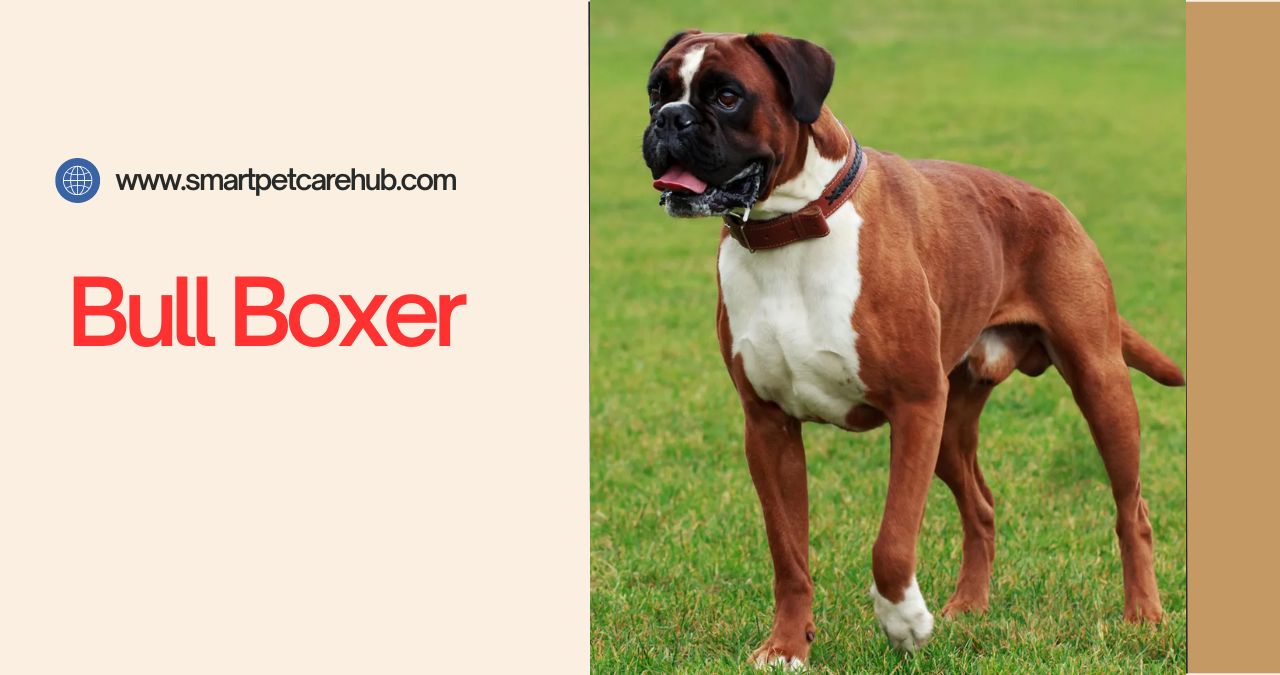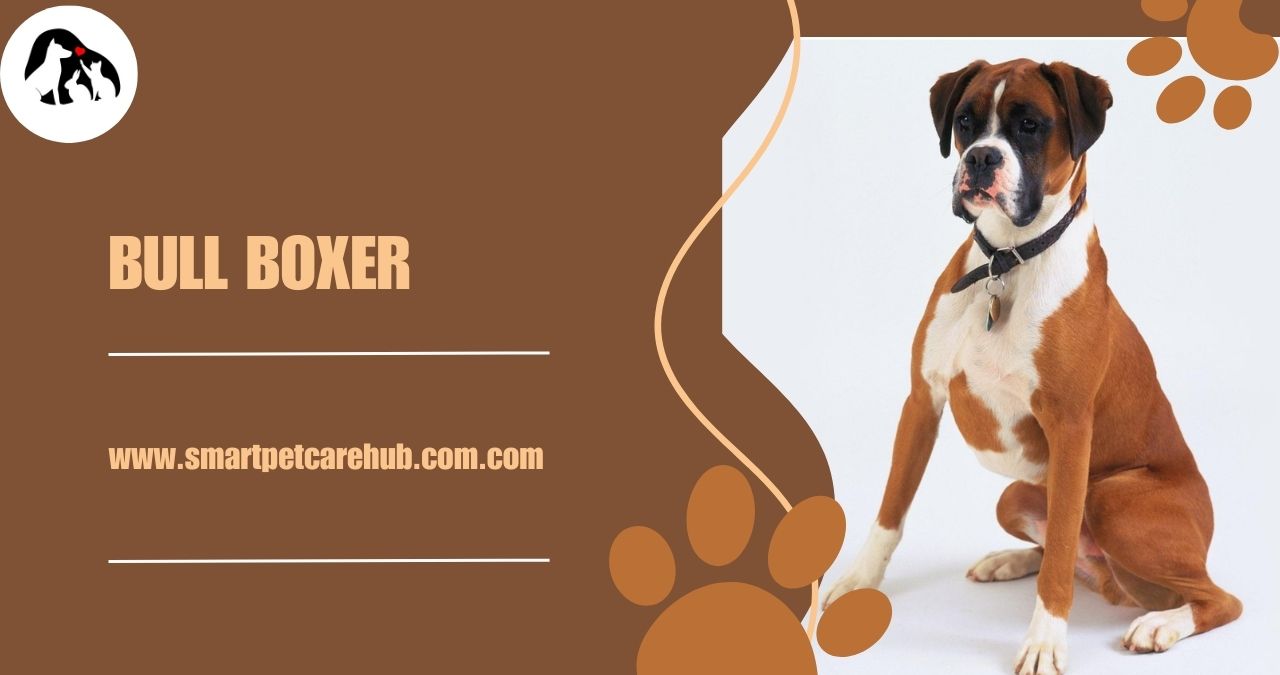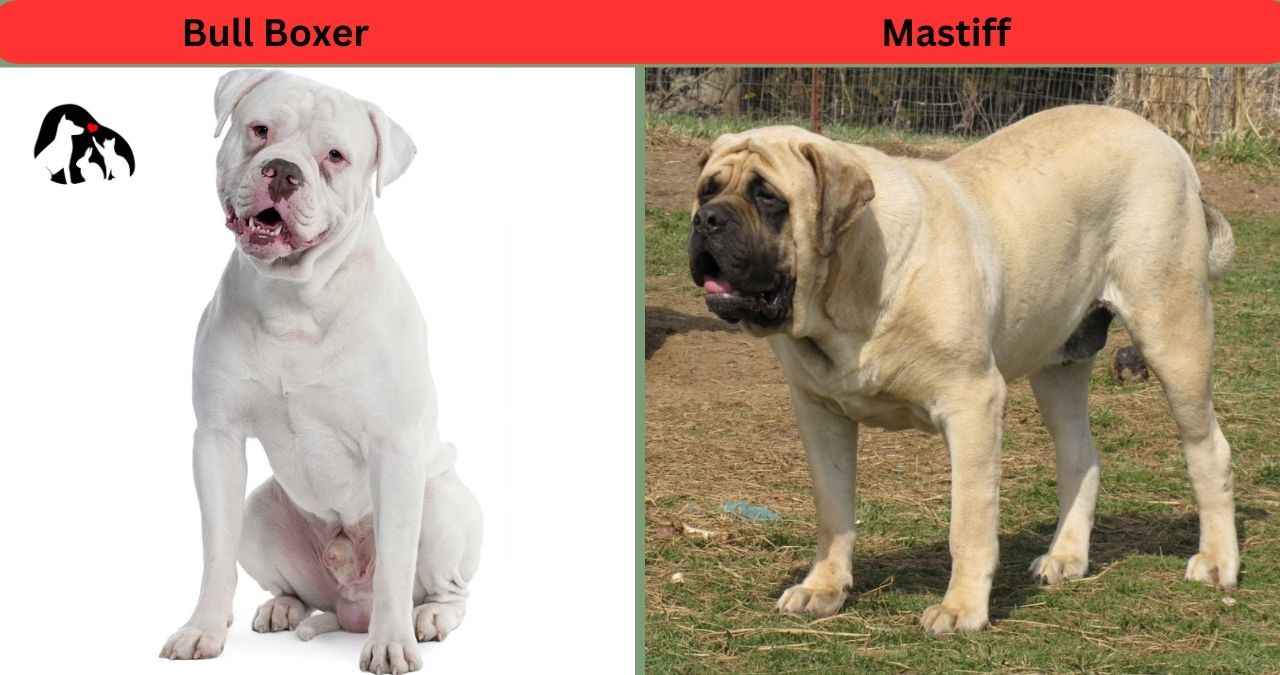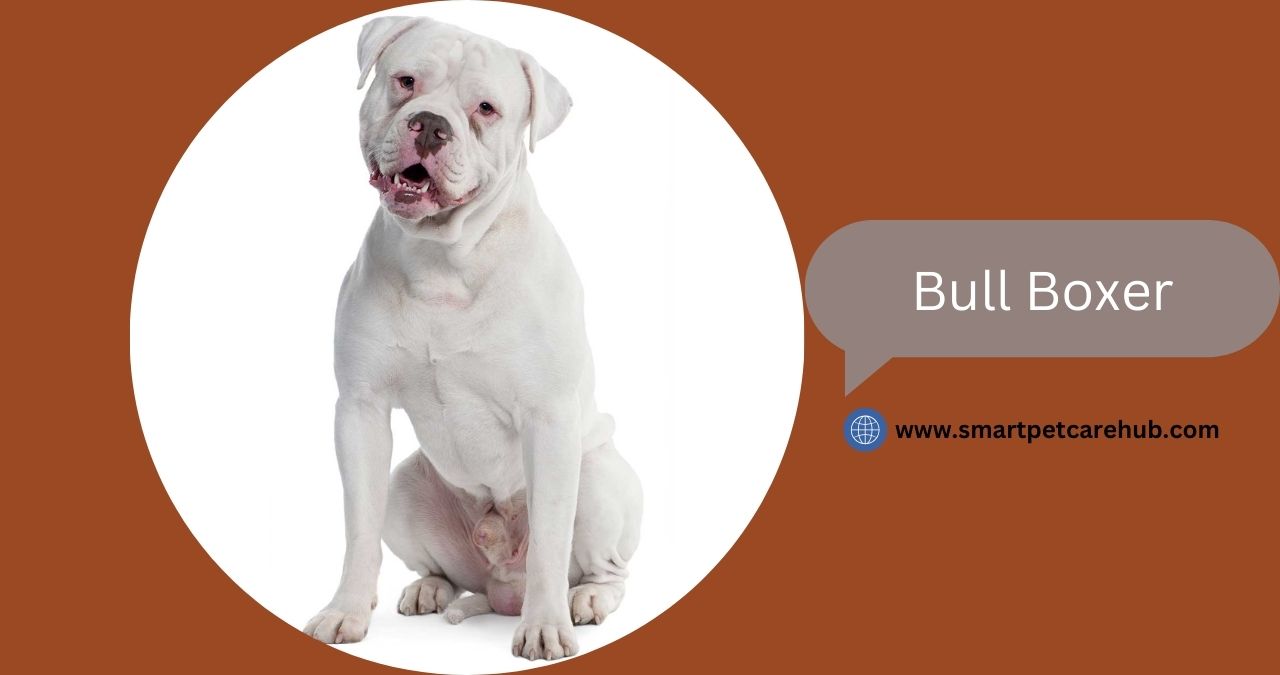Identification of the Bull Boxer
Bull Boxer is a hybrid breed resulting from a cross between a Bulldog and a Boxer. This mix combines the sturdy, muscular build of both breeds as well as their friendly and protective nature. Below is a detailed identification of the Bull Boxer based on its physical characteristics.
Size : The Bull Boxer is a medium to large-sized dog, typically standing 20 to 25 inches (51 to 63 cm) tall at the shoulder. In terms of weight, they usually range from 50 to 80 pounds (23 to 36 kg), with males often being larger and heavier than females. Their muscular and athletic build reflects the physical makeup of both the Boxer and the Bulldog, making them a strong and agile dog.
Color : The Bull Boxer’s coat color can vary widely depending on the parents, but typically includes brindle, fawn, brown, black, white, or a combination of these. Some Bull Boxers may have a solid color in their coat, while others may have patches or distinctive markings. The breed’s color diversity is evidence of its mixed heritage, and no two Bull Boxers look exactly alike in terms of color pattern.
Coat : The Bull Boxer has a short, smooth coat that typically requires little grooming. The coat is smooth and shiny, lying close to the body, making it easy to groom and care for. This breed has inherited coat types from both the Boxer and the Bulldog, making it suitable for mild climates. Their coat sheds moderately throughout the year, so regular brushing can help control shedding and keep their coat healthy.
Eyes : The Bull Boxer’s eyes are typically round and expressive, being dark brown or hazel in color. Their eyes convey alertness and intelligence, traits they have inherited from both the Boxer and the Bulldog. They are known for having a vigilant look that reflects their protective nature. The eyes are one of the most distinctive features of the breed, often giving them a charming and affectionate expression.
Head : The Bull Boxer’s head is broad and well-shaped, with a square shape inherited from both parent breeds. It is large and has a strong jaw, showing Bulldog influence, while the slight wrinkles around the forehead and the overall shape of the head can show traits of both Boxer and Bulldog. The head is a strong and defining feature of the Bull Boxer, showing their power and determination.
Ears : The Bull Boxer’s ears can vary depending on the parents. They are often medium-sized and can be either hanging (like a Boxer) or slightly upright with a folded tip (like a Bulldog). The ears are usually set high on the head and can add to the dog’s expressive and alert demeanor. The type of ear will largely depend on which parent breed’s genetics are more dominant.
Mouth : The Bull Boxer’s mouth is characterized by a strong jaw and scissor bite, although some may have an underbite, a trait commonly seen in bulldogs. The lips are often loose, and some may be droopy as well, but this depends on the individual dog’s genetics. Their powerful jaws make them excellent at chewing and gripping, which can come in handy during play or when serving as a protective guard dog.
Legs : The Bull Boxer’s legs are muscular and strong, built for strength and endurance. The front legs are straight and strong, giving the dog a solid stance, while the hind legs are well-muscled, contributing to their agility and ability to run at good speeds. This breed has inherited the Boxer’s athleticism, allowing them to be fast and agile despite their sturdy build.
Tail : The Bull Boxer’s tail can vary in length. Some dogs may inherit the short, thick tail of the Bulldog, while others may have the long, thin tail of the Boxer. When the tail is long, it is usually slightly curved, while short tails are straight and stiff. The tail is an expressive part of the dog, often wagging vigorously when the dog is excited or happy.
Paws : The Bull Boxer’s paws are compact and strong, with well-arched claws that give them a firm grip on the ground. The paw pads are thick and tough, making them suitable for outdoor activities. Their paws are designed for stability, allowing them to maintain balance even on uneven terrain. This makes the Bull Boxer an excellent companion for both active walks and playtime.
bite force : The bite force of a Bull Boxer probably ranges from 210 to 250 PSI.
average speed : The Bull Boxer combines characteristics of both breeds, with an average speed of 25 to 35 km/h (15 to 22 mph).
average life : The average lifespan of a Bull Boxer is typically 10 to 15 years.

Birth place of the Bull Boxer
The Bull Boxer is a mixed breed created by crossing the Boxer and the Bulldog, and since it is a hybrid rather than a recognized purebred, there is no specific “birthplace” for the Bull Boxer. However, its parent breeds have different origins:
The Boxer originated in Germany in the late 19th century.
The Bulldog has roots in England, dating back to the 13th century.
Given that the Bull Boxer is a relatively recent designer dog breed, its development likely began in the United States or Europe, where crossbreeding between the Bulldog and the Boxer became popular to combine their qualities. Therefore, the birthplace of the Bull Boxer is likely the result of modern breeding trends in these regions.
Other name of the Bull Boxer
The Bull Boxer is most commonly known by that name, but due to its mixed-breed nature, it may sometimes be referred to using variations based on the parent breeds. Here are some alternative names or descriptions for the Bull Boxer:
Boxer Bulldog Mix
Bulldog Boxer Mix
Boxer Bulldog Hybrid
Bulloxer
These names emphasize the mix between the Boxer and Bulldog breeds, making it clear that the Bull Boxer is a crossbreed. However, “Bull Boxer” is the most widely recognized name.
Exercise of the Bull Boxer
The Bull Boxer, a mix of Bulldog and Boxer, is an energetic and muscular breed that requires regular exercise to maintain its physical and mental health. Both parent breeds are known for their strength, agility, and endurance, so a Bull Boxer needs consistent and structured activity. Here is a detailed overview of the Bull Boxer’s exercise requirements:
Daily Exercise Requirements : The Bull Boxer generally needs at least 60 to 90 minutes of exercise per day. This can include a mix of walks, runs, playtime, and other activities that allow the dog to expend energy. They are active and lively dogs that thrive on physical challenges, so ensuring they get enough exercise is important for their overall health.
Walking and Running : It’s important to take your Bull Boxer for a daily walk or run. These walks provide mental stimulation and give the dog a chance to explore its surroundings. A brisk walk of about 30 to 45 minutes twice a day helps meet their exercise requirements and keeps them in good shape.
Playtime and interactive games : Bull Boxers love interactive games like fetch, tug-of-war, and Frisbee. These activities allow them to engage with their owners and expend energy. Fetch is especially great for Bull Boxers because they love to chase objects and bring them back, and it provides an outlet for their natural instincts.
Off-leash exercise in a secure area : If you have access to a secure, fenced yard or dog park, your Bull Boxer will benefit from off-leash playtime. They love to run freely and interact with other dogs. Off-leash exercise allows them to stretch their legs and perform natural behaviors like sniffing and exploring.
Mental stimulation : In addition to physical exercise, Bull Boxers need mental stimulation to stay happy and healthy. Puzzle toys, treat-dispensing toys, and training sessions can help keep their minds occupied and prevent boredom. A bored Bull Boxer can become destructive, so mental exercise is just as important as physical exercise.
Training as Exercise : Bull Boxers are intelligent and eager to please, making them relatively easy to train. Incorporating training sessions into their exercise routine provides both mental and physical stimulation. Obedience training, agility training, and even learning new tricks can be a fun and rewarding way to keep your Bull Boxer occupied.
Socializing and Playing with Other Dogs : Bull Boxers are generally friendly and sociable with other dogs, so arranging playdates or a trip to the dog park is a great way to help them burn off energy while interacting with others. Proper socialization also helps them develop good behavior with other dogs and people.
Hiking and Outdoor Adventures : Bull Boxers love outdoor activities like hiking and exploring new environments. Their athleticism makes them well-suited for hiking and adventures in nature. Just be mindful of the weather, as Bull Boxers can be sensitive to extreme heat or cold due to their bulldog ancestry.
Avoid overexertion : While Bull Boxers are energetic, they should not be overexerted, especially in hot or humid conditions. Due to their bulldog ancestry, they can be prone to brachycephalic airway syndrome, which can cause breathing difficulties. Always provide plenty of water and rest breaks during exercise, especially in hot weather.
Adjust for age and health : As your Bull Boxer grows older, his exercise needs may change. Puppies are full of energy and may require shorter, more frequent activity, while adult Bull Boxers thrive with longer, more structured exercise. Senior dogs may need lighter activities such as light walks and shorter play sessions to avoid joint stress.

Grooming of the Bull Boxer
Grooming the Bull Boxer is essential to maintaining his health and ensuring that his coat, skin, and body remain in excellent condition. Below is a 10-paragraph guide that details the various aspects of grooming this hybrid breed.
Coat Care : The Bull Boxer has a short, smooth coat that sheds moderately. Despite being lower maintenance than long-haired breeds, regular brushing is still necessary. Use a soft-bristled brush or rubber grooming glove once or twice a week to remove loose hair and distribute natural oils evenly over the coat, keeping it shiny and healthy. Brushing reduces hair loss and removes dirt or debris that may accumulate during outdoor activities.
Bathing : Bull Boxers do not need frequent bathing, but they should be bathed every 6 to 8 weeks or when they become very dirty. Over-bathing can strip out the natural oils from their coat and skin, causing dryness or irritation. When bathing a Bull Boxer, use a special dog shampoo that is gentle on their skin. After bathing, rinse thoroughly to avoid leaving any residue of shampoo, and dry the coat completely, especially around the skin folds to prevent moisture buildup.
Ear Cleaning : The Bull Boxer’s ears, whether hanging or half erect, require regular attention. Clean the ears weekly using a veterinarian-recommended ear cleaning solution. Use a cotton ball or soft cloth to gently wipe the outer ear and remove any dirt or wax buildup. Be careful not to insert anything deep into the ear canal, as this can cause damage. Regular ear cleaning helps prevent infections, which can occur due to moisture or dirt accumulating in the ears.
Eye Care : The Bull Boxer may occasionally have discharge around their eyes, especially after outdoor activities. Gently wipe their eyes with a damp, soft cloth to remove any debris or secretions. This should be done daily or as needed. Pay close attention to any signs of redness, irritation or excessive tearing, as this may be a sign of an eye infection or other problems that may require the attention of a veterinarian.
Dental Hygiene : Dental care is important to the Bull Boxer’s overall health. Brush their teeth 2 to 3 times a week with a special toothbrush and toothpaste for dogs. Regular brushing helps prevent plaque buildup, tartar formation and gum disease. Dental chews or toys can also help maintain oral hygiene between brushings. Additionally, annual professional cleanings by a veterinarian can keep their teeth in good condition, preventing future dental problems.
Skin check : When grooming, always take the time to check the skin for any signs of irritation, redness, or lumps. The Bull Boxer’s short coat makes skin problems easy to spot, but it’s important to check areas prone to moisture buildup, such as skin folds and the bottoms of the legs. Regular skin checks help catch potential problems like hot spots, rashes, or infections early. If you notice any abnormalities, consult a veterinarian for proper diagnosis and treatment.
Tail care : The Bull Boxer’s tail can be short or medium in length depending on the dog. Brushing the tail is important during coat care, making sure it’s free of dirt and mats. If the tail is cropped, it still needs care, especially around the base, where irritation can occur. Check the tail regularly for any signs of injury or irritation, especially if the dog is very active outdoors, as his tail can get bumped or scratched.
Nail Trimming and Claw Care : Trimming a Bull Boxer’s nails is important for their comfort. Overgrown nails can cause pain and affect their gait. Trim nails every 3 to 4 weeks, using a dog nail clipper or have a professional groomer do it if you’re not sure. Also, check the paws for any cracks, cuts or foreign objects stuck between the toes. If the pads are dry or cracked, apply a paw balm and make sure the paws are clean after walks, especially in rough conditions.
Anal Gland Expression : Bull Boxers, like many other breeds, may occasionally need to have their anal glands expressed. If you notice the dog rubbing or licking excessively, it may be a sign that the glands are clogged or impacted. This procedure can be performed by a groomer or veterinarian. Regular checkups can help prevent discomfort and infection related to the anal glands, ensuring that the dog stays comfortable and healthy.
Cleaning the Genital Area : Proper hygiene in the genital area is essential for both male and female Bull Boxers. Clean the area with a damp cloth when needed, especially after outdoor activities or bathroom breaks. Keeping the genital area clean helps prevent infection, irritation, and bacteria buildup. Female dogs may need extra care during their heat cycle. Regular cleaning promotes good hygiene and prevents the development of odor or health problems.
Common Health Problems of the Bull Boxer
The Bull Boxer, a mix of the Bulldog and the Boxer, can inherit health problems common to both parent breeds. While hybrid breeds like the Bull Boxer may benefit from hybrid vigor (increased health due to genetic diversity), they are still prone to certain health conditions. The most common health problems seen in the Bull Boxer are as follows.
Hip dysplasia : The Bull Boxer can inherit hip dysplasia from any of the parent breeds. This condition occurs when the hip joint does not develop properly, leading to arthritis and discomfort as the dog ages. Regular vet checkups and maintaining a healthy weight can help manage symptoms.
Heart problems : Both the Boxer and the Bulldog are prone to heart conditions, particularly aortic stenosis and cardiomyopathy. These conditions affect the heart’s ability to pump blood effectively, leading to symptoms like lethargy, coughing, and difficulty breathing.
Brachycephalic syndrome : If a Bull Boxer inherits the Bulldog’s short, flat face, they may experience brachycephalic syndrome, which can lead to breathing difficulties. This condition is caused by the dog’s small airways, making it difficult for them to breathe, especially in hot weather or during vigorous exercise.
Allergies and skin conditions : Bull Boxers are prone to allergies, which can cause itching, redness, and skin infections. These allergies can be triggered by food, environmental factors (such as pollen or dust) or contact allergies (such as certain cleaning products). Dermatitis is another common skin problem.
Hypothyroidism : This condition occurs when the thyroid gland does not produce enough hormones, leading to weight gain, lethargy, and skin problems. Hypothyroidism is common in both Boxers and Bulldogs, and Bull Boxers can inherit this condition as well.
Joint Problems : In addition to hip dysplasia, Bull Boxers can also suffer from elbow dysplasia and other joint-related problems, especially as they age. These conditions can cause pain and mobility issues. Proper weight management and regular exercise can help minimize the effects of these problems.
Cancer : Boxers, in particular, are prone to developing certain types of cancer, such as mast cell tumors and lymphoma. Bull Boxers may also be at risk, so it is essential to monitor them for lumps or unusual changes in their skin and overall health.
Gastric Dilatation-Volvulus (Bloat) : This condition, more commonly known as bloat, occurs when the stomach twists and fills with gas. It is a serious and life-threatening condition that requires immediate veterinary attention. Deep-chested dogs like Bull Boxers are especially susceptible to bloat.
Joint and ligament injuries : Active dogs like the Bull Boxer are prone to anterior cruciate ligament (ACL) tears and other joint injuries due to their high energy and physical activity. These injuries may require surgical intervention and can be prevented by avoiding strenuous exercise, especially on slippery surfaces.
Eye problems : The Bull Boxer may have entropion (inward turning of the eyelid) or cherry eye (forward turning of the third eyelid). These conditions can cause discomfort and may require surgery. Regular eye exams can help detect these problems early.

Popular Bull Boxer Mixed Breeds
The Bull Boxer is a mix of a Bull dog (usually the American Bulldog) and a Boxer. This hybrid breed often has the best qualities of both parent breeds, including strength, intelligence, and a friendly nature. Here are some popular mixed breeds in which the Bull Boxer is one of the parent breeds:
Bull Boxer Retriever : This mix is a mix of the Bull Boxer and the Labrador Retriever. They are known for their friendly and sociable nature, which makes them great family pets. They require regular exercise and enjoy activities like fetch and swimming.
Bull Boxer Beagle : The Bull Boxer Beagle mix provides a playful and affectionate companion. Beagles are known for their keen sense of smell and energetic personality, which is well balanced with the strength of the Bull Boxer. This mix is friendly, curious, and well behaved with children.
Bull Boxer Pitbull : A mix between a Bull Boxer and a Pitbull, this breed is often strong and athletic. They are known for their loyalty and protective nature. With proper training and socialization, they can be great companions and family pets.
Bull Boxer Mastiff : The Bull Boxer Mastiff blends the strengths of both breeds, resulting in a large and powerful dog. They are known for their gentle nature and protective instincts, making them great watchdogs and loyal family members.
Bull Boxer Rottweiler : This mix combines the Bull Boxer with the Rottweiler, creating a strong and confident dog. They are generally protective and loyal, making them great family dogs. Early training and socialization are essential to ensure a well-behaved pet.
Bull Boxer German Shepherd : Mixed with the German Shepherd, this breed is intelligent and versatile. They are loyal, protective, and highly trainable. Their energy levels require regular exercise and mental stimulation.
Bull Boxer Dachshund : The Bull Boxer Dachshund mix is a small breed that retains the playful and affectionate nature of both parent breeds. They are friendly, sociable, and good with children. Their small size makes them suitable for apartment living, but they still require regular exercise.
Bull Boxer Corgi : This mix blends the Bull Boxer with the Corgi, resulting in a playful and intelligent dog. They are generally friendly and social, enjoying interacting with people and other pets. Their compact size makes them suitable for a variety of living situations.
Bull Boxer Chihuahua : A small mixed breed, Bull Boxer Chihuahuas can be lively and affectionate. They have strong personalities and require socialization to interact well with larger dogs and children.
Bull Boxer Great Dane : This mix results in a large and powerful dog that has a gentle temperament. Bull Boxer Great Danes are generally friendly and good-natured, making them excellent family pets. Their size means they need plenty of space and regular exercise to stay healthy and happy.


Leave a Reply
You must be logged in to post a comment.